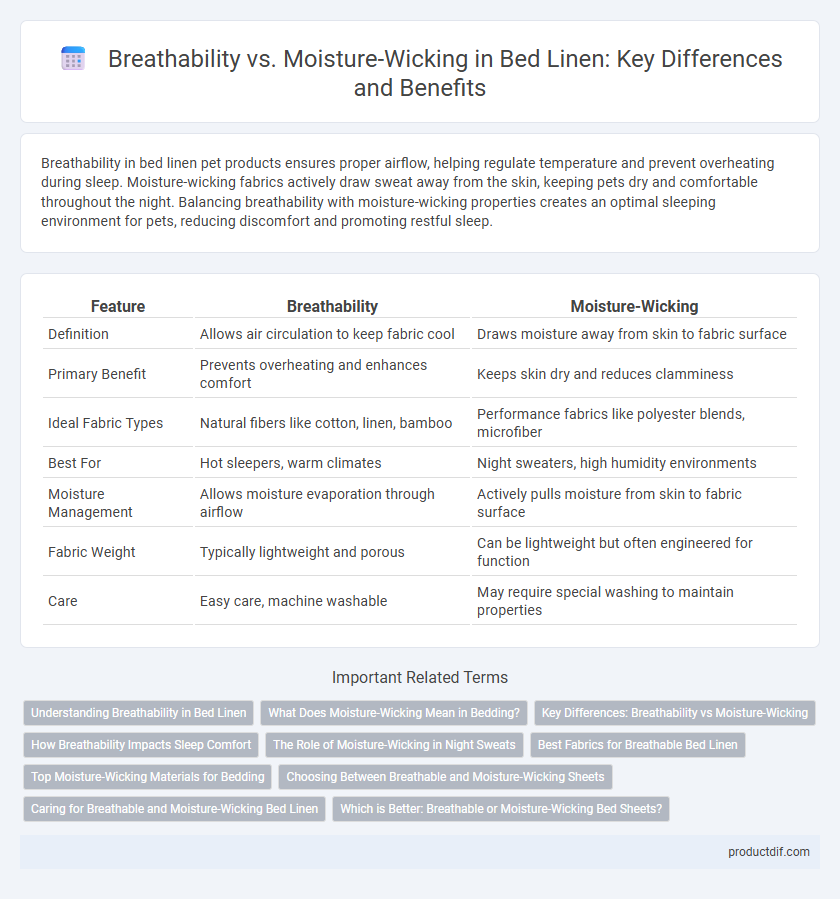Breathability in bed linen pet products ensures proper airflow, helping regulate temperature and prevent overheating during sleep. Moisture-wicking fabrics actively draw sweat away from the skin, keeping pets dry and comfortable throughout the night. Balancing breathability with moisture-wicking properties creates an optimal sleeping environment for pets, reducing discomfort and promoting restful sleep.
Table of Comparison
| Feature | Breathability | Moisture-Wicking |
|---|---|---|
| Definition | Allows air circulation to keep fabric cool | Draws moisture away from skin to fabric surface |
| Primary Benefit | Prevents overheating and enhances comfort | Keeps skin dry and reduces clamminess |
| Ideal Fabric Types | Natural fibers like cotton, linen, bamboo | Performance fabrics like polyester blends, microfiber |
| Best For | Hot sleepers, warm climates | Night sweaters, high humidity environments |
| Moisture Management | Allows moisture evaporation through airflow | Actively pulls moisture from skin to fabric surface |
| Fabric Weight | Typically lightweight and porous | Can be lightweight but often engineered for function |
| Care | Easy care, machine washable | May require special washing to maintain properties |
Understanding Breathability in Bed Linen
Breathability in bed linen refers to the fabric's ability to allow air circulation, promoting a cooler and more comfortable sleep environment by reducing heat buildup. Materials such as cotton, linen, and bamboo excel in breathability due to their natural fiber structure that facilitates airflow. Understanding breathability helps consumers choose bedding that maintains optimal temperature regulation, balancing comfort with moisture management during sleep.
What Does Moisture-Wicking Mean in Bedding?
Moisture-wicking in bedding refers to the fabric's ability to draw sweat and moisture away from the skin to the fabric's outer surface, where it evaporates quickly. This feature keeps sleepers dry and comfortable throughout the night, reducing clamminess and overheating. Breathability relates to how well air circulates through the fabric, complementing moisture-wicking by promoting ventilation and temperature regulation.
Key Differences: Breathability vs Moisture-Wicking
Breathability in bed linen refers to the fabric's ability to allow air to circulate, promoting ventilation and keeping sleepers cool by dissipating heat. Moisture-wicking focuses on drawing sweat and moisture away from the skin to the fabric's surface, where it can evaporate quickly, helping to maintain dryness. While breathability manages airflow for temperature regulation, moisture-wicking actively manages perspiration to enhance comfort during sleep.
How Breathability Impacts Sleep Comfort
Breathability in bed linen enhances airflow, allowing heat and moisture to escape, which prevents overheating and promotes a cooler sleep environment. High breathability materials such as cotton, linen, and bamboo help regulate body temperature by facilitating vapor transfer, reducing night sweats and discomfort. This improved thermal regulation directly contributes to deeper, more restful sleep by maintaining optimal comfort throughout the night.
The Role of Moisture-Wicking in Night Sweats
Moisture-wicking bed linens play a crucial role in managing night sweats by drawing sweat away from the skin, promoting faster evaporation and maintaining a dry sleeping surface. Fabrics such as bamboo, microfiber, and specialized polyester blends offer superior moisture-wicking properties compared to traditional cotton, enhancing comfort and reducing heat buildup. Effective moisture management in bed linens helps prevent discomfort and skin irritation, ensuring a cooler and more restful night's sleep.
Best Fabrics for Breathable Bed Linen
Cotton and linen are among the best fabrics for breathable bed linen, promoting airflow and temperature regulation throughout the night. Bamboo fabric also excels in breathability while offering natural moisture-wicking properties, making it ideal for hot sleepers. These materials help reduce sweat accumulation and maintain a cool, comfortable sleeping environment.
Top Moisture-Wicking Materials for Bedding
Top moisture-wicking materials for bedding include bamboo, Tencel, and microfiber, known for their superior ability to draw moisture away from the skin, promoting a dry and comfortable sleep environment. Bamboo fabric offers natural breathability and antimicrobial properties, making it ideal for hot sleepers who need effective sweat absorption. Tencel fibers provide excellent moisture management and softness, while microfiber sheets combine durability with moisture-wicking capabilities for long-lasting comfort.
Choosing Between Breathable and Moisture-Wicking Sheets
Choosing between breathable and moisture-wicking bed linen depends on your sleeping environment and personal comfort needs. Breathable sheets, often made from natural fibers like cotton or linen, promote air circulation to keep you cool and prevent overheating. Moisture-wicking fabrics, such as bamboo or synthetic blends, actively pull sweat away from the skin, ideal for hot sleepers or those experiencing night sweats.
Caring for Breathable and Moisture-Wicking Bed Linen
Breathable bed linen enhances airflow, reducing heat buildup and maintaining a comfortable sleeping environment, while moisture-wicking fabrics actively draw sweat away from the skin to keep you dry. To care for breathable and moisture-wicking bed linens, wash them in cold water with mild detergent to preserve their fabric technology and avoid fabric softeners that can clog fibers, reducing effectiveness. Regular gentle drying or air drying helps maintain the integrity of moisture management properties and prolongs the lifespan of these performance fabrics.
Which is Better: Breathable or Moisture-Wicking Bed Sheets?
Breathable bed sheets, typically made from natural fibers like cotton or linen, allow air circulation to regulate temperature and prevent overheating during sleep. Moisture-wicking bed sheets, often crafted from synthetic materials such as microfiber or performance fabrics, actively draw sweat away from the body to keep the skin dry and comfortable. Choosing between breathable and moisture-wicking sheets depends on individual sleep preferences and conditions, with breathable sheets offering superior airflow and moisture-wicking sheets excelling in moisture management.
Breathability vs Moisture-wicking Infographic

 productdif.com
productdif.com